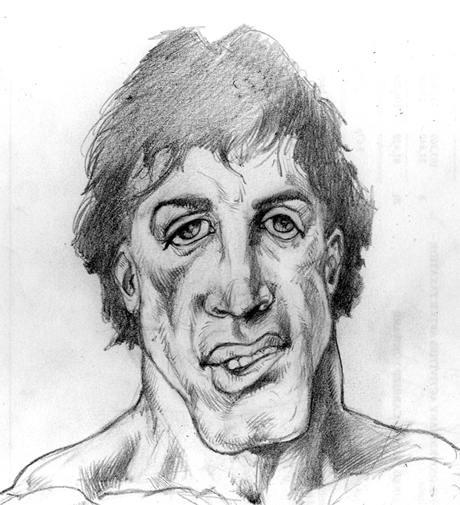The Guardian reports on an interesting study that suggests police should skip photofit composites and go with exaggerated caricatures of criminals instead.
A study at the University of Central Lancashire found that over-emphasising prominent features on people’s faces made them twice as easy to identify than before… On average, a photofit face was correctly identified 20% of the time, compared with 40% for the caricature, according to a report in this month’s Visual Cognition journal.
That’s really interesting. Getting closer to the truth by warping reality. Point out what’s different, what’s obvious, what’ll really help to identify someone. After all, positive identification — not photorealism — is the ultimate goal.
If the guy has a distinctive chin, play that up in the sketch. If he has distinguishing eyes, highlight them. If he has a unique crook to his lips, draw ‘em so you can’t miss ‘em.
A photorealistic sketch is an exercise in accuracy, but an exaggerated caricature is an exercise in identity. Of course this is just one study, but it’s an interesting look at what really matters to get a job done.


Peter Cooper
on 26 Nov 07This somewhat applies to the Getting Real concept as well in the whole “put 100% into 50% of the features” sense. A lot of poorly designed apps often tend to seem very “well rounded” and “smooth” design-wise, but are functionally poor because nothing particularly stands out (compare Hotmail to Gmail, Hotmail looks slicker, but Gmail focuses on the few features that really count).
Benjy
on 26 Nov 07Interesting… initially, one would certainly think that the most accurate would be the most helpful but this makes a ton more sense. Come to think of it, most composites shown on the news look so generic that they could basically be anyone. The only unique characteristics are usually the clothing/accessories (think unabomber w/ glasses & hood) yet those are also the most easily changed!
BTW, does this mean those guys who work at Six Flags are now going to get hired away by police departments?
MattH
on 26 Nov 07Fascinating. Accentuate the uniqueness.
Did Rocky Balboa commit a crime?
ffriend
on 26 Nov 07That is stallone.
JD
on 26 Nov 07I find characatures highly controversial and I object to the use of race- and ethnicity-based stereotypes on which the artists are likely to rely.
Steve
on 26 Nov 07“Did Rocky Balboa commit a crime?”
Rocky 4 & Rocky 5. Those were criminal.
B
on 26 Nov 07I find characatures highly controversial and I object to the use of race- and ethnicity-based stereotypes on which the artists are likely to rely.
Instead of assuming the worst, how about having some faith in professional caricature artists to make the right call about facial features that would be important and useful in the pursuit of a criminal? Can you look at someone without being racist? Why do you assume someone else can’t? Or are you trying to project your racist leanings on someone else?
If an individual has a big forehead or a pronounced chin or a big nose or distinctive lips or a signature scar or a missing tooth or pointed ears, then let’s accentuate them. These are their features.
If it’s accurate, and it helps catch the criminal, let’s do it. Black, white, brown, yellow, or whatever, if accurately highlighting obvious features of a person’s face will help the public identify a criminal, I’m all for it.
JD
on 27 Nov 07B, you prove my point exactly! A big forehead? A big nose? DISTINCTIVE LIPS? RACIST!
random8r
on 27 Nov 07Yeah, that’s great, except that to do a caricature, the artist has to study the subject a great deal.
I think you’d find it would be really hard for an artist to do caricatures from memory.
Pretty silly when you view it like that.
C. Callosum
on 27 Nov 07In machine learning, discriminative training methods that minimise classification error have been gaining popularity for some years now because of their greater accuracy. Caricatures are just like discriminative training – the features that are most likely to distinguish someone from the general population are emphasised, making correct identification more probable.
Benjy
on 27 Nov 07I remember learning in animation that because there is less detail in cartoon-style characters, those that are drawn with exaggerated movements seem more realistic, than those who try to imitate ‘real’ movement.
Similarly, Rotoscoping (tracing animation directly from film) produces a strange and often lifeless result.
Maybe photofits are part of the Uncanny Valley hypothesis?
laure
on 27 Nov 07that makes sense. when you try to remember someone, don’t you remember this person by details ? when you try to remember how someone looked like, don’t you still get it by details but not a complete picture ? I know that’s the way it is with me, at least. the same idea with dreams. and isn’t it logical : why use our memory for unuseful informations ? anyway, it goes in the way of what I heard about how our memory and dreams work (catching details, “putting it in drawers” which you’ll pull whenever you’ll need the information, so as to do “economies”).
z
on 28 Nov 07fantastic illustration of why communication is not about stating fact.
This discussion is closed.